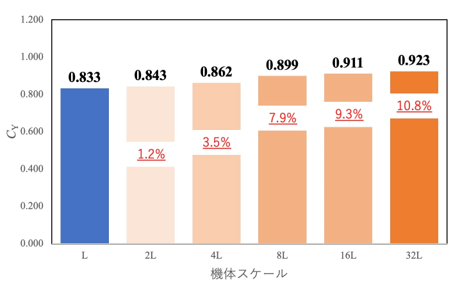Reynolds Number Effects on Aerodynamics of Slender Body with Protuberance
JAXA Supercomputer System Annual Report February 2023-January 2024
Report Number: R23EACA21
Subject Category: JSS Inter-University Research
- Responsible Representative: Keiichi Kitamura, Supervisor Associate Prof., Yokohama national university
- Contact Information: mineshima koya(mineshima-koya-kt@ynu.jp)
- Members: Kohei Kawai, Keiichi Kitamura, Tomohiro Mamashita, Koya Mineshima, Sora Yasui
Abstract
In previous studies on subscale models, the protuberance over the vehicle surface had created an asymmetric flow field and side forces. However, it was unclear whether similar results could be obtained at the actual launch vehicle scale. In this study, the total length of the vehicle (and hence, Reynolds number) was numerically changed from 2 to 32 times the wind-tunnel scale under Mach number 1.5.
Reference URL
N/A
Reasons and benefits of using JAXA Supercomputer System
Numerical fluid dynamics calculations are being performed to understand the aerodynamic characteristics of a rocket with a projection. In particular, it is necessary to numerically resolve the flow field near the airframe due to the increase in the Reynolds number and the fine vortices generated by the projection. For this purpose, large-scale numerical calculations with a fine computational grid are required, and JSS3 is used for this purpose. The results of the numerical fluid dynamics simulations on the wind-conducted test scale are close to the results of the wind-tunnel tests. Furthermore, by analyzing the results through visualization and other means, the spatial flow field, which is difficult to obtain in wind tunnel tests, is clarified.
Achievements of the Year
We performed numerical calculations at an angle of attack of 15 degrees and a uniform flow Mach number of 1.5 using an slender body simulating a rocket with a protuberance as shown in Fig. 1. The Reynolds number effect was investigated by increasing the vehicle size from the wind tunnel test scale (Re=1.1e+7) to the actual flight scale (Re=3.4e+8). The results show that the side force coefficient increases with Reynolds number, as shown in Fig. 2. Figure 3 shows the visualization of the streamlines viewed from the front of the vehicle and the vorticity at the x/L=0.8 position. In the starboard flow without the protuberance, the separation position shifts to the leeward side due to the Reynolds number effect. This causes the flow from the starboard side to be more influenced by the attraction of the vortex from the protuberance, and the shift to the leeward side of the separation position to be stronger. On the other hand, in the port side flow with the protuberance, the Reynolds number effect and the effect of the flow from the starboard side cancel each other out and the separation position does not shift nearly as much. The above causes the surface pressure to change only on the starboard side and the side force to increase.

Fig.3: Visualization of streamlines and vorticity at x/L=0.8 as seen from the front of the aircraft.
Publications
– Oral Presentations
– Kohei Kawai, Keiichi Kitamura, “Computational Fluid Analysis on Multiple Flat Plates as Small Distributed Aerodynamic Brake for High-Speed Railways,” ASME-JSME-KSME Fluids Engineering Division 2023, 2023.
Usage of JSS
Computational Information
- Process Parallelization Methods: MPI
- Thread Parallelization Methods: N/A
- Number of Processes: 480 – 3840
- Elapsed Time per Case: 72 Hour(s)
JSS3 Resources Used
Fraction of Usage in Total Resources*1(%): 0.25
Details
Please refer to System Configuration of JSS3 for the system configuration and major specifications of JSS3.
| System Name | CPU Resources Used(Core x Hours) | Fraction of Usage*2(%) |
|---|---|---|
| TOKI-SORA | 5491605.53 | 0.25 |
| TOKI-ST | 81669.74 | 0.09 |
| TOKI-GP | 0.00 | 0.00 |
| TOKI-XM | 53.57 | 0.03 |
| TOKI-LM | 88147.24 | 6.71 |
| TOKI-TST | 943.71 | 0.02 |
| TOKI-TGP | 0.00 | 0.00 |
| TOKI-TLM | 0.00 | 0.00 |
| File System Name | Storage Assigned(GiB) | Fraction of Usage*2(%) |
|---|---|---|
| /home | 1184.17 | 0.98 |
| /data and /data2 | 104618.33 | 0.65 |
| /ssd | 10876.67 | 1.03 |
| Archiver Name | Storage Used(TiB) | Fraction of Usage*2(%) |
|---|---|---|
| J-SPACE | 46.25 | 0.17 |
*1: Fraction of Usage in Total Resources: Weighted average of three resource types (Computing, File System, and Archiver).
*2: Fraction of Usage:Percentage of usage relative to each resource used in one year.
ISV Software Licenses Used
| ISV Software Licenses Used(Hours) | Fraction of Usage*2(%) | |
|---|---|---|
| ISV Software Licenses(Total) | 3531.96 | 1.59 |
*2: Fraction of Usage:Percentage of usage relative to each resource used in one year.
JAXA Supercomputer System Annual Report February 2023-January 2024




